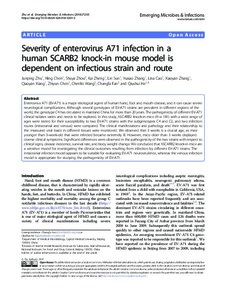Severity of enterovirus A71 infection in a human SCARB2 knock-in mouse model is dependent on infectious strain and route
Changfa Fan; Qiaoyan Xiang; Zhiyun Chen; Lin Sun; Ning Chen; Qiushui He; Shuya Zhou; Kai Zheng; Xiaoyan Zhang; Chenfei Wang; Lina Cao; Junping Zhu; Yuxiao Zhang
Severity of enterovirus A71 infection in a human SCARB2 knock-in mouse model is dependent on infectious strain and route
Changfa Fan
Qiaoyan Xiang
Zhiyun Chen
Lin Sun
Ning Chen
Qiushui He
Shuya Zhou
Kai Zheng
Xiaoyan Zhang
Chenfei Wang
Lina Cao
Junping Zhu
Yuxiao Zhang
NATURE PUBLISHING GROUP
Julkaisun pysyvä osoite on:
https://urn.fi/URN:NBN:fi-fe2021042827002
https://urn.fi/URN:NBN:fi-fe2021042827002
Tiivistelmä
Enterovirus A71 (EV-A71) is a major etiological agent of human hand, foot and mouth disease, and it can cause severe neurological complications. Although several genotypes of EV-A71 strains are prevalent in different regions of the world, the genotype C4 has circulated in mainland China for more than 20 years. The pathogenicity of different EV-A71 clinical isolates varies and needs to be explored. In this study, hSCARB2 knock-in mice (N = 181) with a wide range of ages were tested for their susceptibility to two EV-A71 strains with the subgenotypes C4 and C2, and two infection routes (intracranial and venous) were compared. The clinical manifestations and pathology and their relationship to the measured viral loads in different tissues were monitored. We observed that 3 weeks is a crucial age, as mice younger than 3-week-old that were infected became extremely ill. However, mice older than 3 weeks displayed diverse clinical symptoms. Significant differences were observed in the pathogenicity of the two strains with respect to clinical signs, disease incidence, survival rate, and body weight change. We concluded that hSCARB2 knock-in mice are a sensitive model for investigating the clinical outcomes resulting from infection by different EV-A71 strains. The intracranial infection model appears to be suitable for evaluating EV-A71 neurovirulence, whereas the venous infection model is appropriate for studying the pathogenicity of EV-A71.
Kokoelmat
- Rinnakkaistallenteet [19207]
